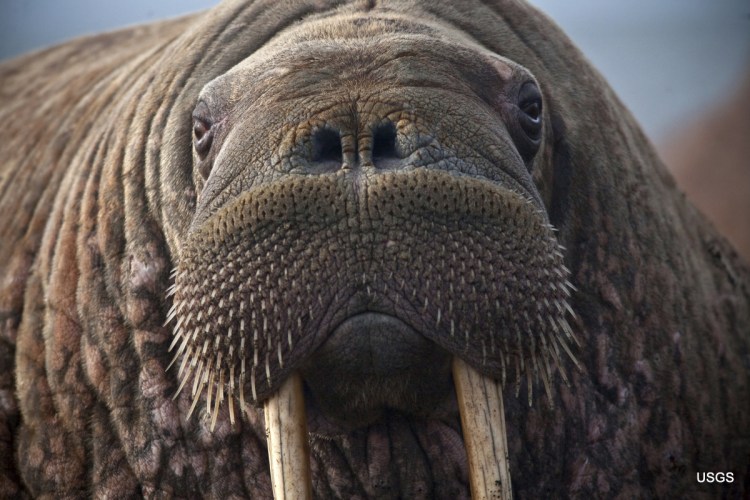ANCHORAGE, Alaska — Given a choice between giving birth on land or sea ice, Pacific walrus mothers most often choose ice.
Likewise, they prefer sea ice for molting, mating, nursing and resting between dives for food. Trouble is, as the century progresses, there’s going to be far less ice around.
How well walruses cope with less sea ice is at the heart of a legal fight over whether walruses should be listed as a threatened species, giving them an added protection against human encroachments.
The federal government in 2008 listed polar bears as a threatened species because of diminished sea ice brought on by climate warming. That year the Center for Biological Diversity petitioned to do the same for walruses.
However, the U.S. Fish and Wildlife Service concluded in October 2017 that walruses are adapting and no one has proven that they “need” sea ice.
“It is unknown whether Pacific walruses can give birth, conduct their nursing during immediate post-natal care period, or complete courtship on land,” said Justice Department lawyers in defending the decision.
A federal judge in Alaska will hear the center’s lawsuit challenging the government’s decision not to list the walrus as threatened. There is no court date set for the lawsuit.
SHIPS, HUMANS INVADING SPACE
Pacific walrus males grow to 12 feet long and up to 4,000 pounds – more than an average midsize sedan. Females reach half that weight. Walruses dive and use sensitive whiskers to find clams and snails in dim light on the sea floor.
Historically hunted for ivory tusks, meat and blubber, walruses since 1972 have been shielded by the Marine Mammal Protection Act. Only Alaska Native subsistence hunters may legally kill them.
An Endangered Species Act listing would require the U.S. Fish and Wildlife Service to designate critical habitat for walruses and plan for their recovery. Federal agencies, before issuing permits for development such as offshore drilling, would be required to ensure walruses and their habitat would not be jeopardized.
Inaccessibility protected walruses for decades, but a rapid decline in summer sea ice has made them vulnerable.
In the Chukchi Sea between Alaska and Russia, where Pacific walrus females and juveniles spend their summer, ice could be absent during that season by 2060 or sooner, according to the Fish and Wildlife Service.
Since 1981, an area more than double the size of Texas – 610,000 square miles – has become unavailable to Arctic marine mammals by summer’s end, according to the National Snow and Ice Data Center.
By late August, as sea ice recedes beyond the shallow continental shelf, female walruses and their calves face a choice: Stay on ice over water too deep to reach the ocean floor for feeding – or come ashore for rest periods, where the smallest animals can be crushed in stampedes triggered by a hunter, airplane or bear.
More open water already has meant more ship traffic. Walruses also could find more humans in their habitat with a reversal of U.S. policy on Arctic offshore drilling. Former President Barack Obama permanently withdrew most Arctic waters from lease sales, but President Trump in April 2017 announced he was reversing Obama, a decision being challenged in court. The administration’s proposed five-year offshore leasing plan includes sales in the Chukchi Sea.
Designating walruses as threatened would mean oil exploration companies would have to consult with federal wildlife officials to make sure drill rigs don’t endanger the animals. However, Trump’s Interior and Commerce departments in July proposed administrative changes to the species law that would end automatic protections for threatened plants and animals and set limits on designating habitat as crucial to recovery.
‘THEY’RE NOT ADAPTING’
Walruses are notoriously difficult to count – and population estimates range widely. A preliminary one in 2017 put the number at 283,213, with the caveat that it could be as low as 93,000 or as high as 478,975.
The array of stresses and uncertainty about the walruses’ future are enough evidence for listing them as threatened, the Center for Biological Diversity argues.
In the last decade, walruses that gathered on shores have suffered hundreds of stampede deaths, and the loss of ice floes has pushed them away from feeding areas, said Shaye Wolf, climate science director for the nonprofit conservation group.
“They’re not adapting. They’re suffering,” Wolf said.
Scientists advising the Fish and Wildlife Service say the answer is not so clear cut, and much is unknown about how sea ice loss will affect walruses.
Chad Jay of the U.S. Geological Survey said it’s unknown, for example, why female walruses give birth on ice instead of land.
“One of the thoughts is that … there’s more protection for the young from predators,” he said. “They’re offshore, and it’s a cleaner environment, too, for giving birth. But those are hypotheses that are difficult to prove.”
Send questions/comments to the editors.



Success. Please wait for the page to reload. If the page does not reload within 5 seconds, please refresh the page.
Enter your email and password to access comments.
Hi, to comment on stories you must . This profile is in addition to your subscription and website login.
Already have a commenting profile? .
Invalid username/password.
Please check your email to confirm and complete your registration.
Only subscribers are eligible to post comments. Please subscribe or login first for digital access. Here’s why.
Use the form below to reset your password. When you've submitted your account email, we will send an email with a reset code.